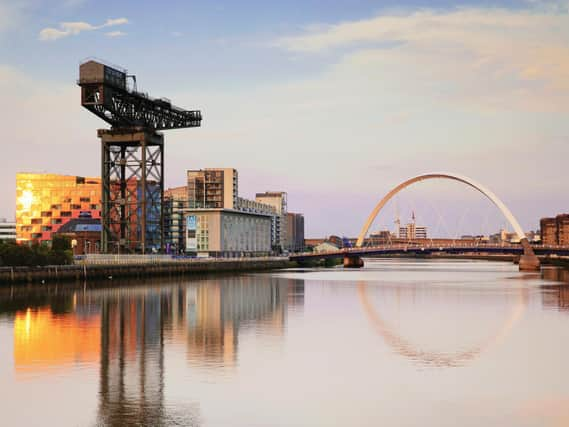Area focus: Finnieston


Once a thriving area of heavy industry on the north bank of the River Clyde in Glasgow Finnieston has now found fame as – arguably – the city’s trendiest neighbourhood, brimming with hip eateries, chic bars and artisanal coffee houses, situated between the city centre and West End.
Its most famous landmark is the Finnieston Crane – officially named the Stobcross Crane – which towers 175 feet over the River Clyde and presents a vivid reminder of Glasgow’s industrial past as the Second City of the Empire.
Advertisement
Hide AdAdvertisement
Hide AdThe outstanding piece of engineering was the largest – and is the last remaining – of several giant cantilever cranes along the industrialised Finnieston waterfront, and was built in 1931 for loading machinery and large steam trains on to ships for export across the world.
Further along the Finnieston Quay are other – more modern – renowned and instantly recognisable landmarks which regularly feature as identifying symbols on artworks and television broadcasts, including the Scottish Event Campus and the Clyde Arc.
The now trendy neighbourhood, which is home to many home-grown celebrities, including Texas singer Sharleen Spiteri and legendary former footballer Danny McGrain of Celtic and Scotland, was formed in 1768, when Finnieston village was established on land at Stobcross Estate.
Merchant John Orr bought Stobcross House in 1745 and his son, Matthew, later developed the village – naming it after his tutor, the Reverend John Finnie.
The former Stobcross railway station operated between 1894 and 1955 before reopening as Finnieston in 1979. It is still in service today as the Exhibition Centre station.
Following the decline of Glasgow’s shipyard industry, the area began to suffer dreadfully and those who can recall the neighbourhood during the 1970s and 1980s, will be pleasantly surprised by the easy-going hipster vibe that now surrounds the community.
Not so surprising, however, is the average cost of a home in the much-coveted Finnieston, which was recorded at £226,498 over the last 12 months, up 9 per cent on the previous year, by Rightmove.
The area largely comprises a mix of new and old flats, and Argyle Street provides its main drag with an abundance of retail and leisure amenities.
Advertisement
Hide AdAdvertisement
Hide AdTo the north of Finnieston is a leafy cluster of traditional yellow sandstone tenement buildings, which can be found on Sauchiehall, Kelvingrove and Derby streets.
South of Argyle Street lies St Vincent Crescent, a highly desirable A-listed terrace constructed in 1850.
Within walking distance of the Exhibition Centre station, which sits on the Glasgow Central line, as well as the city centre, these grand properties are much sought after by those in the know and range in size from two to four-bedroom homes.
Over the last year, they sold for an average price of £364,450, up 3 per cent on the previous year.
A newer collection of sleek two and three-bedroom apartments can be found on Minerva Street and Minerva Way, developed by the Aberdeen-based Drum Property Group.
There are five luxury properties at the development still available and prices start from £355,000.
Schools in the area are Sgoil Ghaidhlig Ghlaschu – Glasgow Gaelic School – on Berkeley Street, which offers primary and secondary education, Hillhead primary and high school off Kelvin Way, while further afield is the girls’ Notre Dame High School, on Observatory Road.
Independent education is available at Kelvinside Academy and The Glasgow Academy, north of the Great Western Road.
Attractions
Advertisement
Hide AdAdvertisement
Hide AdKelvingrove Art Gallery and Museum on Argyle Street is just a stone’s throw from Finnieston and is one of the city’s most famous – and free – attractions. With 22 galleries and exhibits, including Christ St John of the Cross by Salvador Dali, to the 1944-built Spitfire LA198, there is something for everyone. The museum is open 11am-4pm, seven days a week, but to ensure social distancing, booking a free ticket is essential.
SWG3 at the former Customs and Excise warehouse on Eastvale Place, pictured, has remained one of the city’s trendiest arts venues since opening in 2007, with indoor and outdoor spaces available for live music, club nights, food and drink festivals, art exhibitions and filming. Its Acid Bar is a popular meeting spot among locals, serving hot drinks from Finnieston-based The Steamie Coffee Roasters and baked items from the nearby Tantrum Doughnuts in the day, and hosting a rotation of restaurants at night. During this month, the venue is hosting various football-related events to mark UEFA Euro 2020, including showing games on a big screen in its Galvanizers Yard.
The Riverside Museum has been home to Glasgow’s Museum of Transport since it opened in 2011. Designed by Zaha Hadid Architects, the building is worth a visit itself, however inside there are more than 3,000 items on display. Favourites among visitors are the replica cobbled Glasgow street and the Clyde-built tall ship, the Glenlee. The museum is free to enter and open Monday-Sunday between 11am-4pm, but online booking is required.
A message from the Editor:
Thank you for reading this article. We're more reliant on your support than ever as the shift in consumer habits brought about by Coronavirus impacts our advertisers.
If you haven't already, please consider supporting our trusted, fact-checked journalism by taking out a digital subscription